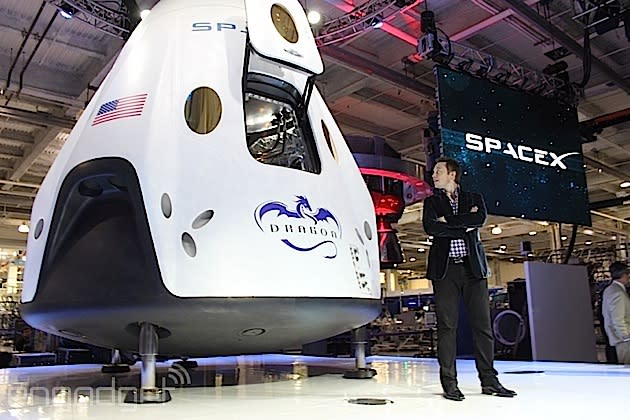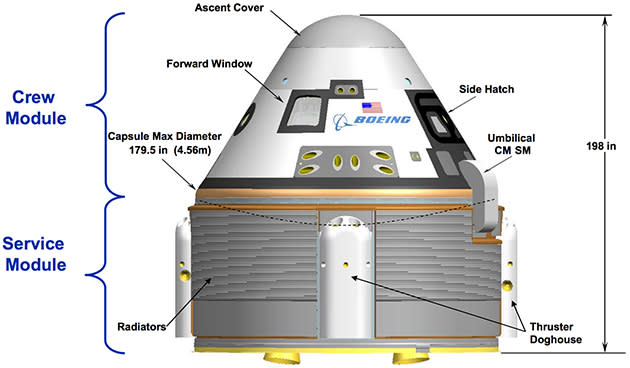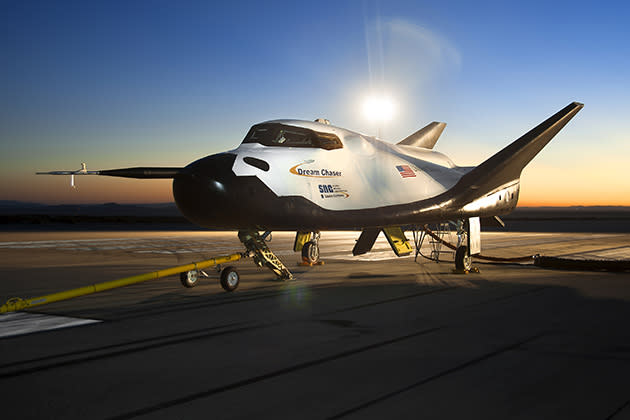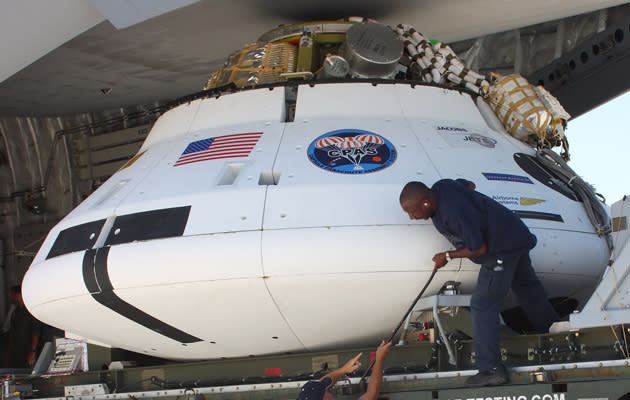Meet NASA's commercial space capsule contenders

Sure, the Dragon V2 is the latest (and greatest) spacecraft from SpaceX, but it's not the only capsule that may one day schlep astronauts to the International Space Station. In fact, Elon Musk's firm is just one of three private outfits currently competing in a NASA program for commercial launches with their own vehicles. We've surveyed the space capsule landscape and have whipped up a primer on the future crafts that may wind up taking humans to space.
Dragon (V2)

The second-gen Dragon just had its coming-out party, but we'll recap the highlights. As SpaceX's workhorse, the original Dragon has sat atop Falcon 9 rockets and carried cargo to the International Space Station, but it hasn't been able to safely transport humans. Dragon V2 remedies that, providing accommodations for up to seven passengers (or less for additional cargo space). What's more, it's expected the capsule can be used up to 10 times before needing significant repairs.
Eight new SuperDraco engines are fitted into the vehicle, allowing it to land on solid ground with the precision of helicopter, all without using a single parachute. Of course, in an emergency, the vessel can use its reserve chutes and drop itself into the sea. A battery of tests is still in the cards for Dragon V2 before it goes airborne, but it's expected to fly with humans aboard in 2016.
CST-100

[Image credit: Boeing, PDF]
Boeing's entry into the commercial crew and cargo program is the Crew Space Transportation-100, or CST-100 for short. In addition to shuttling astronauts to the International Space Station, it's intended to carry folks to private space stations like those proposed by Bigelow Aerospace. When it's tasked with taxiing humans, Boeing's vessel can carry a crew as large as seven.
For landings, the craft slows itself down with parachutes and touches down on terra firma. In the case of an emergency, however, the vehicle can take a dip in the sea.
The CST-100 isn't quite ready to be tossed into the vacuum of space quite yet, but it's making good progress. In February, the hardware that connects it to Atlas V rockets passed muster with NASA, and it's on track to hit the development milestones the space agency is looking for in 2014.
CST-100 | |
|---|---|
Diameter | 4.56 m (15 ft) |
Height | 5 m (16.5 ft) |
Weight | Approx. 9,000kg (20,000 lbs) |
Crew (maximum) | 7 |
Launch Vehicle(s) | Atlas V, Delta IV and Falcon 9 |
Dream Chaser

[Image credit: NASA]
The odd duck in the government's commercial crew program is the Dream Chaser. Rather than rely on a capsule design, Sierra Nevada Corporation's built its astronaut taxi by picking up the space shuttle's mantle. Although it resembles NASA's retired 184-foot long workhorse, it measures up at just 29.5 feet long. Not only does it look like a pint-sized shuttle, but it also functions much like one.
The Dream Chaser uses an entirely different form of controlled descent from its competition. By gliding down from low-Earth orbit, the contraption is able to land at any airport runway suited for commercial airliners. While it builds on the shuttle's strengths, it also inherits some of its weaknesses. Sierra Nevada's solution can handle ferrying up to seven folks to space in low-earth orbit, but it's not fit for long trips to other planets.
In November of 2016, the pint-sized shuttle lookalike is scheduled to make it to orbit for the first time. As if the similarities to NASA's spaceplane weren't enough already, it's set to use the very same runway (for landing) as its much larger doppelgänger.
Dream Chaser | |
|---|---|
Length | 9 m (29.5 ft) |
Wingspan | 7 m (22.9 ft) |
Weight | 11,300 kg (25,000 lbs) |
Crew (maximum) | 7 |
Launch Vehicle | Atlas V |
Orion

[Image credit: NASA, Flickr]
OK, NASA's next-generation space vehicle, Orion, isn't a commercial craft, but it's certainly worth mentioning. Although it was originally devised as part of the now-canceled Constellation program that aimed to take astronauts to asteroids, Mars and the moon, the space agency's building a version of the craft -- with the help of Lockheed Martin -- that'll become its Swiss Army knife. Now dubbed the Orion Multi-Purpose Crew Vehicle (MPCV), it'll be able to make those same trips using a new rocket setup called the Space Launch System. What's more, it'll also be able to haul up to six people to the International Space Station if the need arises.
Returning to Earth for Orion means deploying parachutes and splashing down in the ocean, much like the Apollo missions did. In an emergency, however, the vessel can safely set itself down on soil.
A bit of legwork is still needed before Orion can make its way into orbit, but its first test flight isn't far off. Come December 2014, it'll head 3,600 miles away from our blue marble and land -- if all goes well -- in one piece.
Orion | |
|---|---|
Diameter | 5 m/16.5 ft |
Height | 3.3 m/11 ft |
Weight | 8,913 kg/19,650 lbs |
Crew (maximum) | 6 |
Launch Vehicle | Delta IV, Space Launch System |
Wrap-up
Though each of these commercial vehicles is progressing steadily, it may not be until 2016 that any of them are slung into orbit. Ironically, for as much as NASA's demise is proclaimed, it'll launch Orion before the CST-100 and Dream Chaser even get their first taste of space's vacuum. No matter which company (or companies) NASA ultimately taps for future crew and cargo missions, space aficionados will have the private space race as entertainment.












